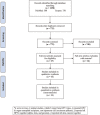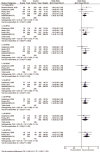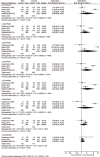A Systematic Review and Meta-Analysis: Evaluation of the β-Human Papillomavirus in Immunosuppressed Individuals with Cutaneous Squamous Cell Carcinoma
- PMID: 33854928
- PMCID: PMC7735980
- DOI: 10.37796/2211-8039.1110
A Systematic Review and Meta-Analysis: Evaluation of the β-Human Papillomavirus in Immunosuppressed Individuals with Cutaneous Squamous Cell Carcinoma
Abstract
Background: Some types of beta-human papillomavirus (β-HPV) may be one of the probable causes of squamous cell carcinoma (SCC) in transplant recipients. β-HPVs are linked to SCC in the literature with small number of subjects.
Aim: Herein, the first meta-analysis was carried out on the association between β-HPVs and cutaneous SCC in immunosuppressed patients.
Methods: A systematic search was carried out in the PubMed and Scopus databases up to December 2018. The odds ratio (OR) were calculated by RevMan 5.3 software and the event rate (ER) by Comprehensive Meta-Analysis 2.0 software with a 95% confidence interval (CI).
Results: A total of 1250 records were identified through the two databases, but at last eleven studies were included in the meta-analysis that they were published from 1989 to 2018. The results showed a significantly high prevalence of β-HPVs in cutaneous SCC patients (ER = 69.1%; 95%CI: 58.7%, 77.8%). In addition, the prevalence of overall β-HPVs and β-HPVs of 5, 8, 9, 17, 49, 75, and 76 in immunosuppressed cutaneous SCC patients was significantly higher compared with controls.
Conclusions: The findings of the present meta-analysis support the hypothesis that β-HPV may play a role in cutaneous SCC development in immunosuppressed individuals.
Keywords: SCC; immunosuppression; meta-analysis; prevalence; skin cancer; β-HPV.
© the Author(s).
Conflict of interest statement
None.
Figures





Similar articles
-
Cutaneous alpha, beta and gamma human papillomaviruses in relation to squamous cell carcinoma of the skin: a population-based study.Int J Cancer. 2013 Oct 1;133(7):1713-20. doi: 10.1002/ijc.28176. Epub 2013 Apr 22. Int J Cancer. 2013. PMID: 23536363 Free PMC article.
-
Two Cases of Cutaneous Squamous Cell Carcinoma Arising in Immunosuppressed Patients with Chronic Human Papillomavirus Infection.Case Rep Dermatol. 2015 Jul 25;7(2):178-82. doi: 10.1159/000438504. eCollection 2015 May-Aug. Case Rep Dermatol. 2015. PMID: 26351427 Free PMC article.
-
Association of Some High-Risk Mucosal Types of Human Papillomavirus with Cutaneous Squamous Cell Carcinoma in an Iranian Population.Iran J Pathol. 2019 Fall;14(4):313-316. doi: 10.30699/ijp.2019.101544.2011. Epub 2019 Sep 22. Iran J Pathol. 2019. PMID: 31754361 Free PMC article.
-
Cutaneous squamous cell carcinoma and human papillomavirus: is there an association?Dermatol Surg. 2013 Jan;39(1 Pt 1):1-23. doi: 10.1111/j.1524-4725.2012.02558.x. Epub 2012 Aug 28. Dermatol Surg. 2013. PMID: 22928516 Free PMC article. Review.
-
Prevalence and Association of Human Papillomavirus with Esophageal Squamous Cell Carcinoma in Iran: A Systematic Review and Meta-Analysis.Iran J Public Health. 2019 Jul;48(7):1215-1226. Iran J Public Health. 2019. PMID: 31497542 Free PMC article. Review.
Cited by
-
Penetrating Exploration of Prognostic Correlations of the FKBP Gene Family with Lung Adenocarcinoma.J Pers Med. 2022 Dec 26;13(1):49. doi: 10.3390/jpm13010049. J Pers Med. 2022. PMID: 36675710 Free PMC article.
-
Comprehensive analysis of prognostic significance of cadherin (CDH) gene family in breast cancer.Aging (Albany NY). 2022 Oct 30;14(20):8498-8567. doi: 10.18632/aging.204357. Aging (Albany NY). 2022. PMID: 36315446 Free PMC article.
-
Human Papillomavirus Related Neoplasia of the Ocular Adnexa.Viruses. 2021 Aug 2;13(8):1522. doi: 10.3390/v13081522. Viruses. 2021. PMID: 34452388 Free PMC article. Review.
-
Human Papillomavirus-Associated Giant Clear Cell Acanthoma and Squamous Cell Carcinoma: A Rare Case Report and Literature Review.J Clin Med. 2024 Apr 24;13(9):2482. doi: 10.3390/jcm13092482. J Clin Med. 2024. PMID: 38731009 Free PMC article. Review.
-
Unraveling the Complex Nexus of Human Papillomavirus (HPV) in Extragenital Keratinocyte Skin Tumors: A Comprehensive Analysis of Bowen's Disease and In Situ Squamous-Cell Carcinoma.J Clin Med. 2024 Feb 15;13(4):1091. doi: 10.3390/jcm13041091. J Clin Med. 2024. PMID: 38398404 Free PMC article.
References
-
- Que SKT, Zwald FO, Schmults CD. Cutaneous squamous cell carcinoma: Incidence, risk factors, diagnosis, and staging. J Am Acad Dermatol. 2018;78:237–47. - PubMed
-
- Pett MR, Alazawi WO, Roberts I, Dowen S, Smith DI, Stanley MA, et al. Acquisition of high-level chromosomal instability is associated with integration of human papillomavirus type 16 in cervical keratinocytes. Cancer Res. 2004;64:1359–68. - PubMed
-
- zur Hausen H. Papillomaviruses in the causation of human cancersea brief historical account. Virology. 2009;384:260–5. - PubMed
Publication types
LinkOut - more resources
Full Text Sources
Research Materials
